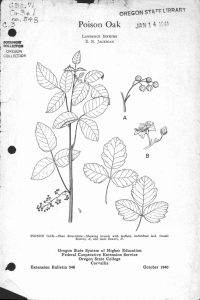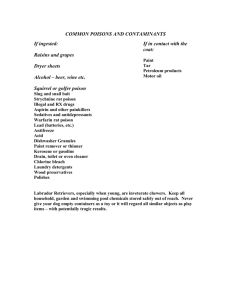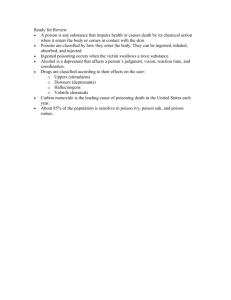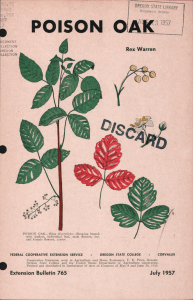Poison Oak DEC 23 ignalanammingsalimmilimmin Oregon State System of Higher Education
advertisement
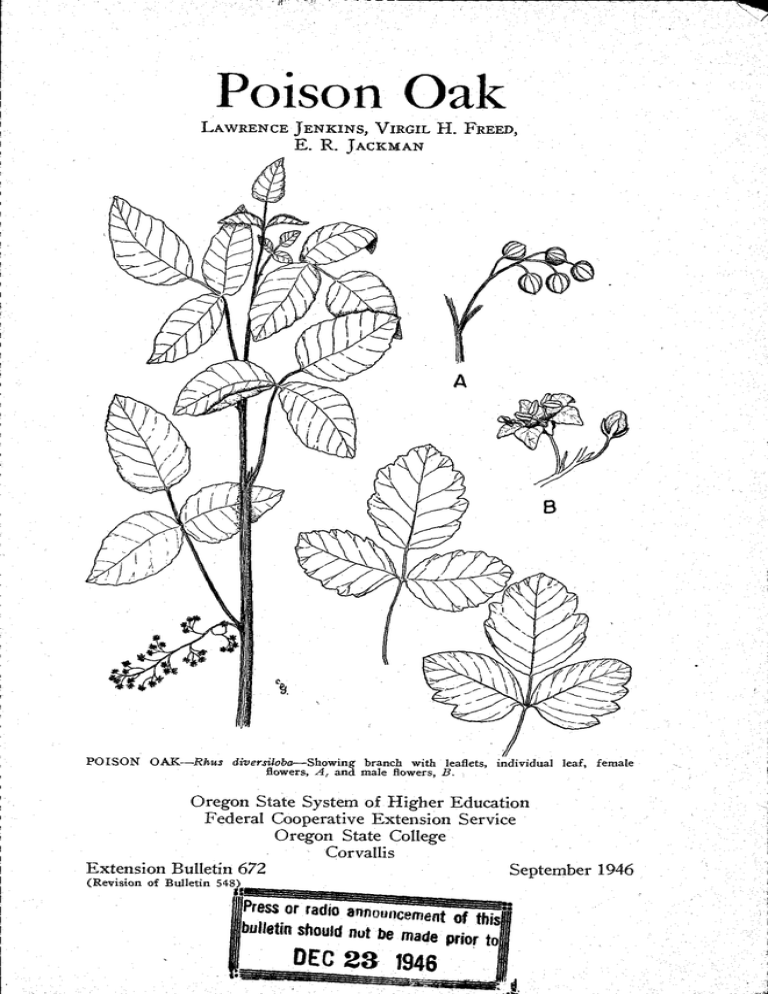
Poison Oak LAWRENCE JENKINS, VIRGIL H. FREED, E. R. JAcKmAN POISON OAKRhus diversiloba--Showing branch with leaflets, individual leaf, female flowers, A, and male flowers, B. Oregon State System of Higher Education Federal Cooperative Extension Service Oregon State College Corvallis Extension Bulletin 672 September 1946 (Revision of Bulletin 548) ignalanammingsalimmilimmin Press or radio announcement of this bulletin should not be made prior to Ill DEC 23 1946 .massulammumems--- Poison Oak (Rhus dtverriloba) By LAWRENCE JENKINS, VIRGIL H. FREED, and E. R. JACKMAN* Illustrations by Cathrme Davis Young OAK is found in most Oregon counties. It will not POISON stand cultivation but thrives and spreads in old pastures, range lands, fence rows, and waste places. It has some value as a browse plant for livestock, especially goats and sheep, and is a source of good-quality honey. Its brilliantly colored fall foliage annually attracts, to their sorrow, a new group of children, city people, or newcomers, who gather it for house decoration. The shrub may grow from 3 to 10 feet tall, erect, thick, and woody, like willow, or may grow as a vine and twine around trees. It is able to reproduce by both seed and rootstocks. It often has aerial rootlets that adhere to the trunks of trees. Leaflets are from inch to nearly 2 inches long, produced 3 in a group on a common stem. An old saying is, "Leaflets three, let it be." The Latin name for the plant, diversiloba, refers to a peculiarity perhaps not found in any other plant : many leaflets have two or three lobes on one side only. Occasionally these lobes occur on both sides, and the leaflets somewhat resemble an oak leaf. The surface of the leaf is conspicuously glossy and may have a blistered appearance. Flower groups are about / inch across, greenish-white, in clusters, on a slender stem. Seeds are borne in berries about the size of currants, greenish-white, smooth but striped, and glossy. They are in grapelike clusters. The entire plant contains at all seasons an oily substance extremely poison- ous to some persons, causing painful irritation of the skin that usually appears only several hours after contact. Human susceptibility varies from extreme susceptibility to near immunity. A few cases have been reported where the poison covered such large areas of the body that death resulted. This is rare, but doctors should be consulted in all extreme cases. To become poisoned, the skin must come into direct contact with this oil either by touching the plant or by touching something that has touched it, such as clothing, gloves, livestock, or firewood. The smoke from poison-oak-wood fires often poisons persons who thought they were immune. It is likely that no one is completely immune to the poison. After exposure to poison oak the hands and arms should be washed thoroughly with strong soap and hot water. The soap should contain an excess of lye. A solution of water and alcohol in equal proportions will dissolve the poison, but the so1ution must be used E. R. Jackman is Extension Specialist in Farm Crops, Lawrence Jenkins was Assistant Specialist in Farm Crops, and Virgil H. Freed is Assistant Agronomist in charge of weed research at Oregon State College. 3 Numerous lotions for relieving the discomfort and curing poison oak burns are on the market. liberally. Control methods. Experimental work over a period of 3 years' testing of various materials on poison oak shows the three most effective materials to be ammonium sulphamate,* sodium chlorate, and 2-4-D. The ammonium sulphamate was the most effective in controlling poison oak. For best results the application should not be made be- fore the last of June and may be made as late as the last of September or the early part of October. This material is dissolved at the rate of 1 pound per gallon of water and the entire plant sprayed until thoroughly wet, but not to the point where excessive run-off occurs. Ammonium sulphamate has no fire hazard in connection with its use and is relatively nonpoisonous to livestock and human beings. It is quite corrosive to spray equipment, which should be thoroughly washed out after being used. Since this material has little value as a soil sterilizer for the control of poison oak, it is necessary to apply it directly to the plant. Best results are obtained during periods of dry warm weather. Sodium chlorate is effective in control of poison oak, but there is some danger in handling it. The chlorate should be mixed at the rate of 1 pound per gallon of water and the resulting solution sprayed on the plant until thoroughly wet, but not until excessive run-off occurs. The use of chlorates presents a dual hazard : (1) of fire, and (2) of stock poisoning. It is suggested that Oregon Agricultural Experiment Station Circular of Information 197 or Extension Bulletin 510 be studied before chlorate is used. 2-4-D has had a limited testing on poison oak and has been found to be somewhat effective in controlling the plant. Application should be made before the first of July for best results. Applications made in August and later show very little control. The recommended dosage for 2-4-D is 2 pounds of parent acid per 100 gallons of spray. More complete information on the use of 2-4-D may be found in Extension Circular 665. The plant should be sprayed until thoroughly saturated with the material. For larger areas the foliage should be burned or cut and the land plowed and cultivated for a period, or planted to a crop that will permit frequent cultivation. Small patches can be grubbed out by a person who is immune to poisoning. Several grubbing-s are required to kill all of the roots. If the land cannot be plowed, probably the best course is to pasture the area severely with goats. The trade name a this material is Animate. ACKNOWLEDGMEIVTS: The authors thank Dr. Helen M. Gilkey, Curator of the Herbarium, for reading the manuscript and checking the description of the plant. Professor G. R. Hyslop, former Head of the Division of Plant Industries, made helpful suggestions Cooperative Extension Work in Agriculture and Home Economics Wm. A. Schoenfeld, Director Oregon State College and United States Department of Agriculture, Cooperating Printed and distributed in furtherance of the Acts of Congress of May 8 and June 30, 1914
